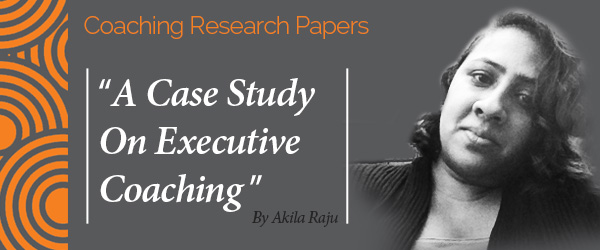Research Paper By Akila Raju
(Career Coaching, INDIA)
Case Study
I had been asked to coach Vinita, a senior team lead whose manager reported that she could not manage her team. Allegedly, Vinita’s influencing tactics could be reduced to one style, she was directive and would tell her team members what to do and if they don’t do it, according to instructions she would scream at them and this led to the teams morale being low and not wanting to work with her or escalate any issues for fear of being reprimanded.
This also resulted in Vinita’s brand within the organisation being diluted and nobody wanted to work in her team. Potential next steps would mean the team members complaining and resigning.
Chemistry Meeting:
When Vinita appeared for an introductory discussion looking distinctly hostile with ‘What’s all this about?’ and ‘I don’t want to be here’ conveyed in every aspect of her tone and manner.
Throughout the meeting, Vinita huddled in her chair with her shoulders pointing away from me, avoiding eye contact and radiating anger with an abrupt and loud voice.
Feeling uncomfortable, I made a conscious attempt to match her posture and voice volume.
I explained who I was and what I hoped we could work on.. VINITA manager had told her to go over and meet me. There was resistance and the attitude of I know it all. I did ask her to give me a background of her team, what she hoped this coaching would help her with?
She was defensive and refused to build rapport. I tried to match her tone and voice with that of mine and I could see resistance but agreed we would meet on a weekly basis. I also asked her to deliberate over what she wanted to achieve through the coaching.
First Meeting:
In our first meeting I approached things differently given my first experience. I asked Vinita to share what she wanted to achieve and if she had thought over it. Her reaction was as expected that she is there to address the feedback that her manager had given her and that’s why she was there.
I then deliberately broke whatever rapport there was, sat up energetically in my chair, then immediately softened my voice and slowed it down, asking her to tell me about the feelings that this apparent feedback on her style was creating for her.
It was hard to keep pushing and questioning in the face of resistance. However, after a few minutes, she slowly swivelled around to face me for the first time and her own voice dropped. We were then in genuine rapport for the first time, and the real conversation could begin
She did highlight the fact that she was hurt and angry about the feedback and she genuinely cared for her team. She was only being harsh because she wanted her team to learn and if she slackens she was afraid from past experience that thjey would take her for granted.
This helped us then break ice and talking about her feelings helped her recognise that she had bottled up negative energy that was affecting her.
We then focused on relaxing and letting go of all the negative energy.
I asked Vinita to take deep breaths and as she exhaled, also breathe out the negativity and anger. This calmed her down and at the end of the first session she was able to build rapport to continue on our journey
Goals set by
- To understand what the team thought of her
- To help her with strategies that could help her calm and not sanp at her team
- To become a fulfilled light positive person who was approachable.
The Coaching Process and competencies / tools used
The process of coaching Vinita took about 12 sessions across 4 months.
There were various tools I used during the entire sessions which was listening, questioning, acknowledgement reframing perspectives, visualisation and the power tool of responding vs. reacting.
Given below is an illustration of the coaching process:
1. What does my team think of me?
In order to help Vinita get to know her team better we did a 360 (un attributed and also included questions like what should Vinita Start, stop and continue doing.
This gave Vinita perspectives of not only what she should be doing bit also validate things she was doing well. Vinita was a Subject Matter expert and know her process well. She was the go to person and she could leverage this knowledge to coach more junior folks in the team. Her areas of improvement were to ensure that she stayed calm and not react when things didn’t go well. Also ensure that she creates a collaborative process rather than a DO it approach.
She decided to take the action of starting to connect with her team by organising training sessions. She made the sessions fun and ensured that the team saw her in a different light. She also managed to delegate and let go with more senior folks within the team. She also shared her plan with her manager whose support she enlisted. The manager was her supporter and ensured that she helped create opportunities for Vinita to be more supportive to her team and also gave her insights when Vinita went back to her old ways.
The result was by the end of 12 weeks, her team respected her more. A few of them would approach her with problems. There were fewer errors in her teams work and she had enlisted the support of her most important stake holder her manager.
